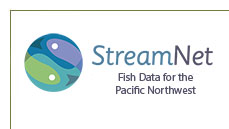The StreamNet Data Store is a searchable archive of data sets related to fish and other aquatic resources that are not of the specific data types included in the main StreamNet database. These data sets come from many different sources and are provided for download in their original formats. To add your own data set to the Data Store, use our Data Publishing Service.
StreamNet did not participate in creation of most of these data sets, and we are not able to answer questions about those we did not help develop. For questions about the data sets available from this page, please contact the originator of the particular data set.
To search the Data Store, enter key words, project numbers, species, methods, etc. into the search box below and click "Search".
Upper Columbia Nutrient Supplementation
|
| Data Categories
|
Age and growth
Measures of habitat quality
Water temperature
Macroinvertebrate sampling
Water quality
Food habits/diet
|
| Dates of Data
|
2008 TO 2015
|
| Data Set Status
|
In work
|
| Data Set Update Schedule
|
None Planned
|
| Date Data Set Published on StreamNet Data Store
|
04-04-2016
|
| Project Name & Number
|
2008-471-00
|
| Purpose of Data Set
|
Pacific salmonid populations have declined dramatically across the Columbia River Basin. These population declines are often due to cumulative effects of multiple factors affecting production in freshwater and marine environments. An important result of these population declines is the concurrent nutrient, productivity, and ecosystem function losses associated with significantly reduced marine derived nutrient (MDN) loading rates from the loss of salmon carcass. Anadromous salmon carcasses provide significant amounts of MDN, which historically provided the bases for primary productivity in stream systems, especially in the interior areas which are naturally oligotrophic. Lower MDN loading from diminished salmon runs results in negative feedback through reduced juvenile rearing capacity for Pacific salmon systems. Recent research has indicated that MDN loading rates as low as 6-15% of historical levels currently exist among anadromous salmon spawning streams in the Pacific Northwest.
This project will quantify and evaluate nutrient status and availability in the Methow River Basin, a Subbasin of the Upper Columbia River watershed area in north central Washington, in response to diminished anadromous salmon runs. More specifically, this project is conducting a rigorous multi-trophic level sampling program to quantify and evaluate baseline water quality and nutrient availability, primary secondary and tertiary productivity rates including algal, periphyton, benthic macroinvertebrate and fish communities . A stratified random sampling design was used to select study sites in each of the upper, middle, and lower reaches of the study area (Twisp River). The goal is to develop a comprehensive pre- and any post-treatment (experimental nutrient addition) biological assessment. Finally, this project provides the necessary adaptive management framework to determine if nutrient limitation and/or imbalance currently exist and to generate empirically-based recommendations and prescriptions for restoring limnological conditions needed to increase natural production of anadromous salmonids in the study area (Twisp River).
|
| Summary / Abstract
|
All data collected from Hancock Springs Nutrient Project related to energy flow webs in a restored spring fed creek. This includes: Electrofishing capture and re-capture fish data (Juv. Chinook, Steelhead, Coho, Brook Trout, Bull Trout, Sculpin); Water Chemistry; Primary Productivity; Macroinvertebrate (aquatic and terrestrial) assemblages; and temperature.
|
| Broad Biological Groups
|
fishes; invertebrates; periphyton
|
| Taxa
|
Oncorhynchus tshawytscha; Oncorhynchus kisutch; Oncorhynchus mykiss; Salvelinus fontinalis; Salvelinus confluentus; Ephemeroptera; Plecoptera; Trichoptera
|
| Location
|
Hancock Springs and Twisp River, Methow River Basin, Okanogan County, Washington State
|
| NPCC Subbasins (2001 Subbasins)
|
Provincial (Columbia Cascade/Wenatchee)
|
| Hatcheries
|
|
| Dams
|
|
| Keywords
|
Hancock Springs; Electrofishing; Restoration; Energy Flow Webs
|
| Lead Person and Organization That Created the Data Set
|
Yakama Confederated Tribes
|
| Other Participating Organizations
|
Funding provided by Bonneville Power Administration
|
| Contact Person for Questions About the Data
|
Name: Teresa Fish
Position:
Organization: Yakama Confederated Tribes
Address: PO BOX 549
Twisp,
WA 98856
USA
Phone: (509) 314-1462
email: fist@yakamafish-nsn.gov
|
| Broad Category of Methods
|
Field; Lab
|
| Data Collection Methods
|
Electrofishing; Periphyton Rock Scraping; Hess Sampler; Lavage; Macroinvertebrate Pan Traps;
|
| File Formats
|
Microsoft Access; Microsoft Word; Microsoft Excel
|
| Data structure description
|
See data set files.
|
| URL where updated data may be available
|
|
|
Some data sets are intrinsically linked to software, tools, models, or statistical procedures, and must be used in
association in order to be of value. If this applies to this data set then the following information will apply:
|
| Relationship between the data set and the software, model, etc.
|
Excel Spreadsheets are used to calculate the coefficients of variation (CV) and populations of fish after each electroshocking effort and Hancock Springs. For electroshocking efforts that required only 2 passes, the fish populations can be estimated using the Seber-LeCren.xlsx spreadsheet. If the electroshocking efforts required more than 2 passes, the populations can be estimated using the "Zippin.xlsx" spreadsheet.
|
| Where the software, tools, models, etc. can be obtained if they are not included with the data download.
|
|
| Contact person for questions about the software, tools, models, etc.
|
Name: Teresa Fish
Organization: Yakama Nation
Address: PO Box 549
Twisp, WA 98856
Phone:
email: fist@yakamanation-nsn.gov
|
| Papers, reports, and presentations that were done under this project.
|
|
| Restrictions or legal prerequisites for accessing and using this data set.
|
Unsure?
|









